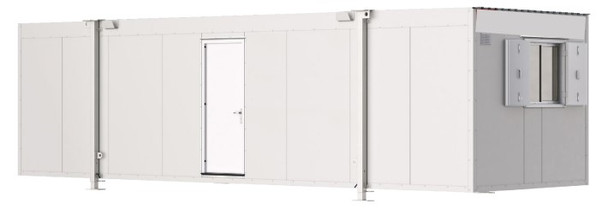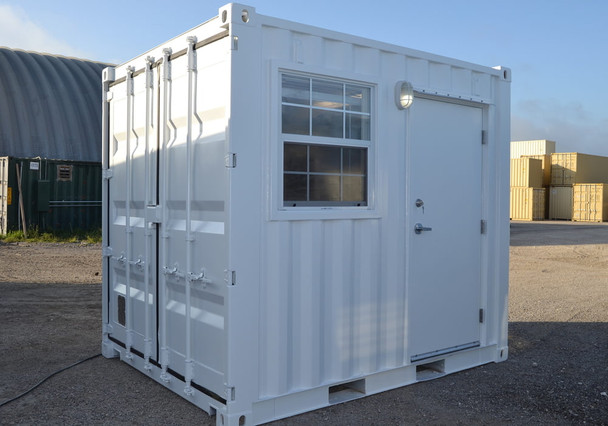How Portable storage Containers Help Reduce Carbon Emissions on Construction Sites
Portable storage containers are temporary structures that can provide an efficient solution for a wide range of construction applications, from office space and meeting rooms, to bathrooms, locker rooms, and more. These housing solutions can significantly reduce carbon emissions because they are made of materials that are both highly durable and sustainable, making them perfect for construction sites. For example, the steel used in constructing these temporary shelters is 100% recyclable, meaning once its useful life on a construction site is over, the materials can be reused again elsewhere thus reduces both costs and waste associated with hazardous material disposal or destruction.
In this article, we will discuss the Ways to Minimize Construction Site Carbon Footprint, Advantages of portable storage Containers for construction sites and Sustainable Construction Techniques.
How portable storage containers reduces Carbon Footprint on Construction Site
The use of Portable storage containers to minimize construction site carbon footprints, have proven to have positive impact on the environment, thus becoming increasingly popular in the construction industry.
The use of temporary, modular buildings for construction sites eliminates the need for traditional, permanent structures made from materials like concrete that require energy-intensive fabrication. This reduces both material waste from unused building elements and greenhouse gas emissions from manufacturing and transport. here are some highlighted features that aid portable storage containers in Carbon Emission on your construction site.
1. Utilizing Sustainable Materials
Portable storage containers are built with the environment in mind. They are made of materials that are both highly durable and sustainable, making them perfect for reducing carbon emissions on construction sites. Theses materials includes Steel, Aluminium, Corten steel, wood and composite material.
2. Durable Materials
The walls of portacabins and shelter containers are constructed from galvanized steel, which is highly resistant to corrosion and damage while providing a strong surface that can withstand harsh environmental conditions such as extreme temperatures. Additionally, these materials are fireproof, providing much needed safety on construction sites.
3. Recycled Steel
The steel used in the construction of portable storage container is 100% recyclable, meaning once its useful life on a construction site is over, the materials can be reused again elsewhere. This reduces both costs and waste associated with hazardous material disposal or destruction.
Portable storage Containers for Site Office 40ft Long
The Materials use for constructing portable storage containers
Portable storage containers are typically made of materials that are highly durable and sustainable, which makes them a popular choice for reducing carbon emissions on construction sites. Here are some materials that are commonly used in the construction of portable storage containers:
1. Steel:
Steel is a common material used in the construction of portable storage containers due to its durability and strength. Steel is also a recyclable material, which makes it a sustainable choice.
2. Aluminum :
Aluminum is another popular material used in the construction of portable storage containers due to its lightweight properties and corrosion resistance. Aluminum is also recyclable, which makes it a sustainable option.
3. Corten steel :
Corten steel is a type of steel that is resistant to corrosion and weathering, making it a durable option for outdoor use. Corten steel is also recyclable, making it a sustainable choice.
4. Wood :
Wood can also be used in the construction of portable storage containers, particularly for their flooring and internal structure. Using sustainably sourced wood, such as FSC-certified wood, can make portable storage containers more eco-friendly.
5. Composite materials :
Composite materials, such as fiberglass reinforced plastic (FRP), can also be used in the construction of portable storage containers. These materials are lightweight, durable, and require minimal maintenance, making them a sustainable option.
By using durable and sustainable materials in the construction of portable storage containers, they can be reused and recycled, reducing waste and lowering the carbon footprint of construction sites.
Sustainable Construction Techniques using portable storage containers
Portacabin and shelter containerscan be assembled quickly without the need for resources such as fuel and electricity, thus reducing their carbon footprint significantly. Additionally, their modular design makes them easy to transport from site to site with minimal disruption.
1.Reducing Waste Through Efficiency
Portable storage containers are essential tools for reducing the amount of waste and subsequently carbon emissions generated on construction sites. By providing on-site accommodation, offices, canteens and other necessary facilities, they require less energy to build than traditional, permanent structures. Additionally, the fact that these solutions are transportable means that they can be moved around and repurposed for different worksites whenever needed, leading to considerable long term savings in material resources.
These solutions also reduce waste output in several other ways. For instance, their lightweight frames make them easy to install without the need for large machinery or complex foundations. This also reduces the amount of soil disturbed or removed during construction or expansion works, thereby protecting the environment from further damage. Furthermore, as most portacabins and shelter containers are delivered as a complete package that requires minimal assembly on site, they leave behind virtually no waste after deconstruction.
Finally, by providing an enclosed environment with proper insulation throughout the year including during winter months, portacabins and shelter containers help reduce energy consumption at construction sites. This can be accomplished by installing air conditioning systems with high energy efficiency ratings or connecting to renewable energy sources like wind or solar power to further reduce carbon emissions.
2.Optimizing on-Site Electricity & Water Usage
Portable storage containers offer a variety of ways to reduce energy and water-related emissions on construction sites. From installing energy-efficient light bulbs to reducing on-site water usage, these methods can help reduce overall carbon emissions and lower costs.
3.Energy-Efficient Light Bulbs
One way to reduce carbon emissions on construction sites is by switching from less efficient to more energy-efficient light bulbs. These bulbs use less electricity than their traditional counterparts, making them an ideal choice for use in portacabins and shelter containers. Additionally, they also produce a longer lifespan than traditional light bulbs, saving money in the long run.
4.Reduced On-Site Water Usage
Another useful way to reduce carbon emissions on construction sites is by reducing on-site water usage. By using greywater systems, water can be recycled and reused for other purposes instead of being wasted. This saves energy by reducing the amount of energy needed to pump and heat new water, while also reducing the amount of waste that must be disposed of after the project is complete.
By using innovative approaches such as energy efficient light bulbs and greywater systems in portacabins and shelter containers, construction companies can reduce their carbon emissions and save money in the long run. In addition, these methods can help ensure that projects are completed in an environmentally friendly way.
5.Foster Eco-Friendly Building Practices
Portacabins and shelter containers can help reduce carbon emissions on construction sites in a number of ways. As buildings become more sophisticated and use more electricity, it is important to be mindful of how materials are sourced and used in construction.
6.Reduce Carbon Footprint of Transportation Costs
By using prefabricated buildings, resources can be delivered directly to the site rather than hauled in via truck or rail. This helps reduce the transportation emissions associated with traditional construction methods and gets materials to the job site faster.
7.Reduce Construction Waste
Unlike traditional framing or stick-built construction, portacabins and shelter containers require far fewer resources, resulting in less waste during building production. Not only does this reduce landfill filling, but it helps save energy as resources are reused instead of discarded.
8.Improve Energy Efficiency
Prefabricated buildings have improved insulation properties which help reduce energy costs during use. They also take advantage of natural lighting which helps further reduce energy costs associated with traditional stick-built buildings.
Conclusion
Portable storage containers are an essential part of every construction site due to their ability to reduce carbon emissions and through their innovative design and ability to be adapted to a range of environments, Portable storage containers offer an efficient, cost-effective, and eco-friendly solution to the issue of carbon emissions on construction sites. Furthermore, they can be used in the future to help create a more sustainable built environment. By investing in portacabins and shelter containers, construction sites can take a significant step towards reducing their environmental footprint.
To get the many benefits of portacabins and shelter containers for your construction sites, contact GZ Industrial Supplies today we can help provide a comfortable, energy-efficient environment for workers, which can significantly reduce carbon emissions.









